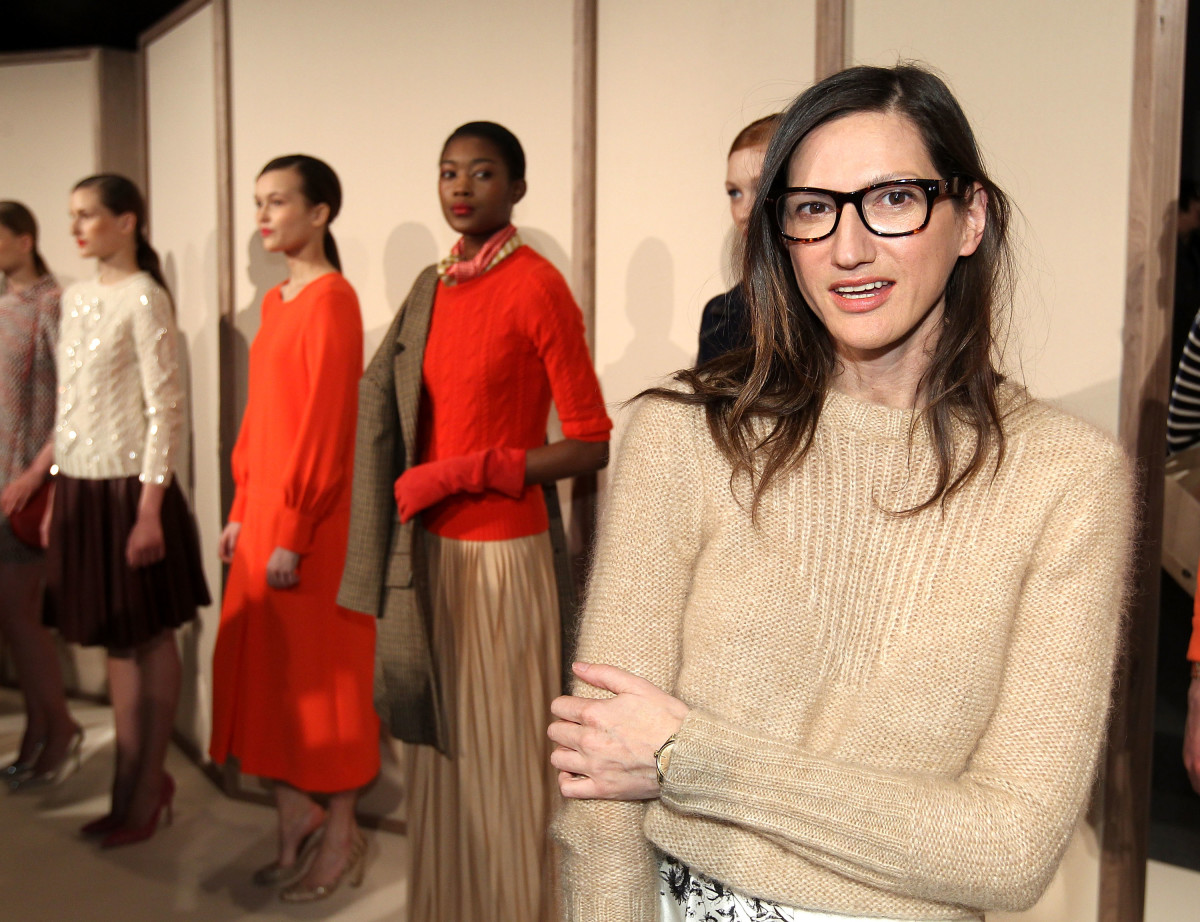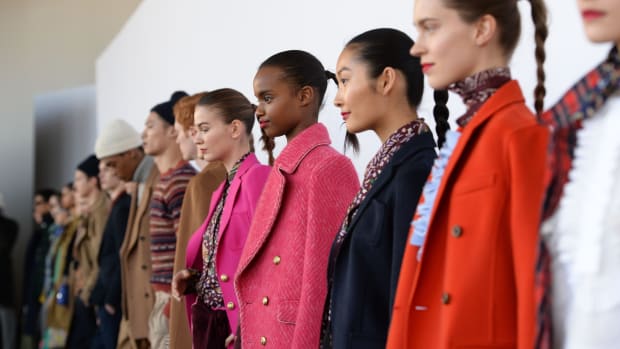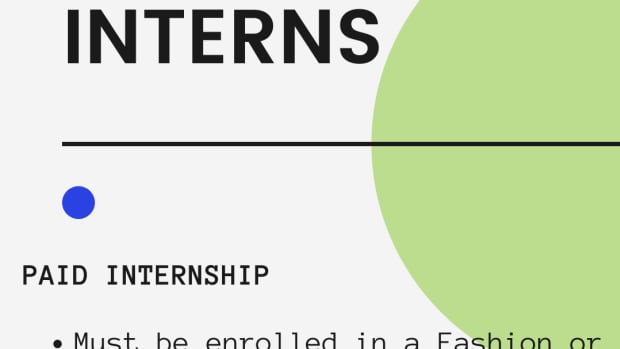"It is the inalienable right of every man, woman and child to wear khaki," begins "The Official Preppy Handbook," a tongue-in-cheek classic first published in 1980. "In a true democracy, everyone
can be upper class and live in Connecticut. It's only fair."
In the 40-plus years since the reference guide hit bookshelves, the world has changed, and so has prep along with it. No longer are double-breasted blazers reserved for boarding school brats with Saab 900s back home. Today's prep is for everyone, more or less. It's only fair, after all.
For the fashion community here in the U.S., prep's egalitarian resurgence started taking shape in 2018, when designers were showing New York Yacht Club-style staples in droves. As starched collars, varsity jackets and layered cardigans flooded the Spring 2019 collections, it became clear that prep was back, baby, and it was less buttoned-up than ever.
For preppies, this was big news. The last time the Ivy League aesthetic hit it this big was the '80s, when retailers like Lacoste, Brooks Brothers and, naturally, Ralph Lauren were there to spread the wealth, and in certain cases, the alligator polos. Then there was J.Crew, which spent the Reagan era mastering American Prep — capital "A," capital "P" — as we still define it four decades later: effortless, unpretentious, aspirational.
Just when fashion editors were filling their trend reports for the season, J.Crew was in desperate need of a turnaround. Not only were revenues consistently down, but in 2017, creative director and president Jenna Lyons — the doyenne of J.Crew, if you will — had stepped down. Three weeks later, the New York City-based company cut 250 staff positions. Come spring of 2020, J.Crew Group had officially filed for bankruptcy, canceling plans to take its fast-growing sister brand Madewell public.

Jenna Lyons at J.Crew's Fall 2012 presentation during New York Fashion Week in February 2012.
Photo: Dario Cantatore/Getty Images for Mercedes-Benz Fashion Week
But J.Crew, which declined to comment for this story, isn't dead in the water. Last November, it promoted former Madewell head Libby Wadle to CEO of J.Crew Group; in May, it tapped Brendon Babenzien, co-founder of streetwear scion Noah and a former Supreme designer, to lead its men's business.
Wadle and Babenzien have their work cut out for them, of course. But it's looking like prep isn't going anywhere anytime soon. And on the other side of that Chapter 11-sized mountain is enormous opportunity: to tap into what J.Crew did — does — best.
In the late '80s and early '90s, while Al Gore's internet began gaining steam, J.Crew was making a name for itself the old-fashioned analog way: with catalogs. On those pedigreed pages, J.Crew presented a far more accessible vision of prep, because the basics of prep are just that — basic. An artfully wrinkled tee here, a pleated pair of trousers there. Clothes you might already have in your closet. Clothes you can really, truly live in.
"When you wear a button-down, you lean into prep, whether you realize that or not," says longtime fashion marketer Cieja Springer, VP, Brand Integration at creative agency 19th & Park Inc. "You don't have to have Sperry's on to align with the prep community."
It wasn't always this way. In theory, prep is still vaguely associated with Hyannis Port leisure activities — think tennis or squash, or serving Cape Codders to women named "Muffy" — that are typically seen across the Northeast and New England. But in practice, the style has its roots somewhere more specific, and that's a little New Jersey institution called Princeton University.
According to Deirdre Clemente, a historian and curator of 20th-century American material culture, the origins of prep are inseparable from the blue-blazer culture of Princeton through the '20s and '30s. For reasons both academic and societal, she says, Princeton had the right demographic mix to be the Ivy League trendsetter. It was a place where personal style thrived, within certain parameters.
"When you think about prep, one of the big elements is the disconnection of the suit," explains Clemente, who authored the book, "Dress Casual: How College Kids Redefined American Style," in 2014. "And what do you see the boys at Princeton doing? They're the first to break apart the suit and make it stylish." And so, casualwear was born: Once you break apart the suit (or in the case of the women of Wellesley College, the A-line dress), you're able to mix and match.
Prep has ebbed and flowed ever since, losing its elitist appeal during the Great Depression and coming back to life in Lilly Pulitzer's '60s Palm Beach playpen. So why might prep, with its country-club reputation, be making a comeback now, in a post-pandemic era anchored in self-expression? Clemente offers the example of Christian Dior's New Look, a 1947 collection that celebrated ultra-femininity at a time when women had just grown accustomed to the convenience of pant legs.
"After huge cultural change, there's always a pushback and a desire to return to how things were," she says. "What prep provides for people is a baseline of getting a little bit dressed up."
As is the trend cycle's wont, the prep of 2021 looks different than it did in the '80s when J.Crew started gaining traction. It feels different, too — consider Recreational Habits, a just-launched luxury label that, in its own words, celebrates "the preppy American spirit through an inclusive lens."
"The 'new prep' is really more about growing up and understanding that you can keep culture and sophistication all together," says co-founder Marlon Muller, who created the brand with his wife, Barneys New York and Kith alumna Jackie Skye Muller, to open up the historically white world of "prep culture" to a larger group of people.
Recommended Articles
It's a sentiment Cam Wolf, style feature writer at GQ, believes can be traced back to streetwear, a category with which prep now happens to be linked: "Prep is thriving because it's glommed onto the big, catch-all term of streetwear. I don't think prep works so much as it did a couple of decades ago. It has to have these extra ingredients."
Sometimes, that spice comes from aesthetic cues, like an offbeat graphic woven into cable knit or a color-blocked loafer styled with track pants. Other times, it can be attributed to something more intangible that builds brand loyalty.
Babenzien's Noah, which he first introduced in 2002, has incubated a community around both pillars. Aesthetically, it animates prep's drowsier staples with youthful elements more regularly acknowledged across fringe categories, like skatewear, surfwear and punk fashion. But it's also done so without losing its way ethically. As GQ pointed out in a recent profile, Noah gives one percent of its annual sales to grassroots environmental groups and releases collaborations to support social causes throughout the year.
The brand itself will admit it's not perfect. (Its website's own "On Sustainability'' page kicks off with the headline, "We Are Not a Sustainable Company.") Yet for shoppers, how important is the fine print? They know the brand stands for something — anything — and that's what matters when building a business for the TikTok generation. The real question is: Can Babenzien plant those magic beans into a mall brand?
"When you're buying Noah, you're buying into a culture and a value system," says Wolf. "What works for [Babenzien] at Noah is that he does have such a specific point of view. I'm a little bit skeptical that he'll be able to build that culture on the same scale at J.Crew."
This is not to say that companies of J.Crew's magnitude — a reported $2.5 billion in annual revenue, with 9,400 employees — aren't able to prioritize gutsy small-brand ethics. (Just look at Patagonia, the star student.) In fact, J.Crew was once the greatest thing a brand could be, commercially speaking: "J.Crew was an early adopter of lifestyle," designer Peter Som told Sarah Brown in a recent Town & Countrytribute to the so-called #OldJCrew. "It wasn't just about a product shot, but how do you live your life in these clothes?"
"Their success was built on giving people what they wanted, right? That was high-quality basics, and that's what their market should be," says Clemente, the historian and curator. "You're paying a little bit more, but you know what you're getting and you know it's going to last. The audience J.Crew is trying to get is going to pay an extra 50 bucks for good-quality cashmere."
Devotees of the J.Crew catalog era know that to be true — Clemente certainly does. But she found the brand faltering in the early- to mid-aughts, two whole decades before it found itself in bankruptcy proceedings. She references J.Crew's bridal line, which launched in 2004 as a wallet-conscious, taffeta-free alternative to multi-thousand-dollar wedding gowns and offensive bridesmaid attire; the range was a hit, but it shuttered in 2016 for reasons The New York Times speculated "came down to numbers."
J.Crew's fatal flaw was not launching bridal, however. It wasn't Jenna Lyons' departure, either. And it certainly wasn't launching the sub-brands it quickly scrapped, like Playa and Nevereven. Instead, it was an age-old tale of overextension.
"Who are you?" Clemente asks of the retailer. "Are you the sexy bridesmaid? Or am I able to get a great sweater set from you that I can pass on to my kid?"
"J.Crew needs to get back to the core of what it is, and that is a prep brand," says marketing professional Springer. "Prep is cool. It's just about how you showcase it."
For Springer, this is as much about the clothes themselves as it is about how they're sold — and who's buying them: "I would hope J.Crew takes a moment to lean into what the world looks like. I think what someone like Jenna Lyons did well is she diversified the brand. You saw a lot more models of color during her era in both women's and men's collections. That opened up the conversation for the brand to be cool because Black people are pop culture. If we're not wearing it, then no one's going to wear it."
A J.Crew turnaround isn't an impossible task. Wadle, J.Crew Group's new CEO, has a years-long track record of scaling Madewell into the company's crown jewel. She's also realistic about where the brand can go from here, which may entail going back to where it started: tousled pullovers you can wear at a Nantucket bonfire or on a crowded subway car while running errands.
"Everyone has a J.Crew love story," Wadle told Fortunein a June interview, "but more and more people, I think, have had a J.Crew breakup story. They want to find that love connection again."
GQ's Wolf, for one, is selfish in his rallying cry for a J.Crew return. It was his tried-and-true option for — you guessed it — the basics. It kept shopping simple, knowing where to go and for what.
"It's nice to have a J.Crew in your life," he says. "People will be so ready to embrace it with open arms."
Psychologists agree: The last 17-odd months have made us all more wistful. In bouts of crisis, humans tend to reach for nostalgia, seeking comfort in earlier, less threatening days. It's why Clemente surmises prep began surging again in the first place. But this crisis is different: Do we want to return to the "before," or do we want to reinvent what kinds of lives we lived and the clothes we wore to live them? All of this could play to J.Crew's advantage.
"The individualized wardrobe is going to be more important than it ever has been in human history," Clemente says. "J.Crew has a chance to get in on the reinvention of the American wardrobe. The boundaries between what you can and can't wear have all been taken down. The only person who says what the boundaries are, really, is you."
Want more Fashionista? Sign up for our daily newsletter and get us directly in your inbox.





